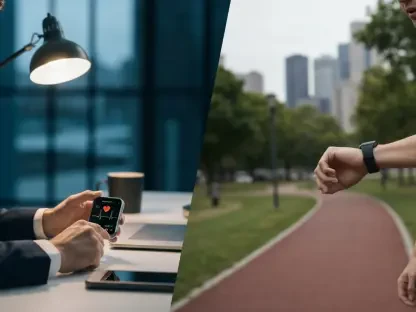In a groundbreaking move, Google has joined forces with Samsung and Qualcomm to unveil Android XR, a new platform designed to amplify the potential of extended reality (XR) through advanced headsets and innovative glasses. Drawing upon the technological infrastructure that made Android a household name across billions of devices worldwide, Google aims to revolutionize computing experiences for everyone. By integrating artificial intelligence (AI), augmented reality (AR), and virtual reality (VR) technologies, Android XR seeks to make interactions with devices more intuitive, seamless, and engaging.
Transformative Collaboration
Engineering the Future of XR
Google’s partnership with Samsung and Qualcomm is a strategic alliance that leverages each company’s technological strengths to create a robust and versatile XR platform. This collaborative effort is poised to enhance the capabilities of XR devices, facilitating a more immersive and natural user experience. Building on the solid foundation of Android, the new OS aims to blend cutting-edge technology with everyday life, offering a futuristic vision of seamless digital integration. The introduction of Gemini, an AI assistant capable of understanding user intent and providing contextual assistance, is central to this vision. Gemini can support users in planning, researching, and guiding tasks, offering a glimpse into a more connected future.
The first headset, codenamed Project Moohan and developed in collaboration with Samsung, is named Kelvin and slated for release next year. Kelvin promises to enable seamless transitions between virtual immersion and real-world presence. This revolutionary headset allows users to interact with virtual environments, fill spaces with applications and content, and utilize reimagined Google apps like YouTube, Google TV, Google Photos, and Google Maps in innovative ways. This advancement underscores Google’s commitment to transforming computing by enhancing user interactions and creating a more cohesive digital ecosystem.
Developer Collaboration and Ecosystem Expansion
Harnessing Familiar Tools for Innovation
Android XR’s compatibility with existing Android tools such as ARCore, Android Studio, Jetpack Compose, Unity, and OpenXR ensures that developers can begin creating for these new XR devices immediately. This integration allows developers to utilize familiar tools and frameworks, reducing the learning curve and accelerating innovation. The platform’s open nature provides fertile ground for a diverse array of XR devices and applications, stimulating user choice and enhancing accessibility to media and software in immersive formats.
Partners like Lynx, Sony, and XREAL have already expressed their intention to leverage this platform to introduce varied devices catering to both consumer and business needs. This collaborative environment fosters a vibrant ecosystem where developers and creators can craft novel experiences using established tools. The extended support network provided by Google and its partners is pivotal in this journey, enabling real-world testing of prototypes and ensuring that development processes are efficient and streamlined.
Envisioning a Future with XR Glasses
One of the key aspects of Android XR’s future roadmap is the extension of its capabilities to smart glasses, aiming to offer all-day assistance. These advanced glasses aim to integrate artificial intelligence directly into the user’s line of sight or ear, providing practical functionalities such as directions, translations, or message summaries without the need to use a phone. The vision is to create a personal assistant that is always available, helping users navigate through their day with ease and efficiency. By seamlessly blending digital information with physical surroundings, these glasses represent a significant step toward a more connected and informed society.
The push for continuous innovation and integration of AI, AR, and VR into everyday devices signifies a major paradigm shift in personal and professional computing. Google’s strategy to cultivate an open and unified XR platform encourages the development of a wide range of devices and applications, meeting diverse needs and preferences. This endeavor emphasizes Google’s evolving vision of computing, driving forward innovation and making technology more accessible and integrated into daily life.
Paving the Way for Digital Integration
Creating a Unified and Accessible XR Ecosystem
The overarching consensus within the tech community is that Android XR, by establishing a unified and open platform, is set to drive the creation of an extensive XR ecosystem. This innovation creates opportunities for developers and users alike, fostering a diverse range of devices and applications. Users benefit from improved access to their favorite apps and games in immersive environments, making interactions more intuitive and enjoyable. The platform’s open nature and developer-friendly tools are pivotal in this ecosystem, ensuring that creators have the resources needed to build next-generation XR experiences.
This extensive integration of AI, AR, and VR into daily devices marks a significant transition toward more advanced personal and professional computing. The real-world testing of prototypes by partners and comprehensive support for developers are crucial steps in this ambitious journey. Google’s strategic vision and collaborative approach with leading tech giants underscore their commitment to driving innovation and accessibility in the realm of extended reality.
Conclusion
In a pioneering step, Google has partnered with Samsung and Qualcomm to launch Android XR, a cutting-edge platform designed to elevate the capabilities of extended reality (XR) through state-of-the-art headsets and innovative glasses. By leveraging the same technological foundations that have established Android as a ubiquitous presence on billions of devices worldwide, Google aims to reshape computing experiences for all. The integration of artificial intelligence (AI), augmented reality (AR), and virtual reality (VR) technologies within Android XR promises to make interactions with devices more intuitive, seamless, and engaging. This collaboration marks a significant advancement in the field of XR, highlighting how tech giants are continually pushing the boundaries of what’s possible. With Android XR, users can expect a more interconnected and immersive experience, blending the digital and physical worlds in ways never before achieved. As technology continues to evolve, this new platform has the potential to set new standards and redefine how we interact with our digital surroundings.









